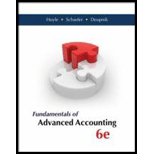
Concept explainers
a.
Identify the consolidation worksheet adjustments which would have been required as of January 1, 2013, to eliminate the subsidiary’s common and preferred stocks.
a.
Explanation of Solution
The consolidation worksheet adjustments which would have been required as of January 1, 2013, to eliminate the subsidiary’s common and preferred stocks:
| Entry S and Entry A | ||||
| Date | Accounts Title and Explanation | Post Ref. | Debit | Credit |
| 01/01/2013 | Common stock | $ 100,000 | ||
| | $ 200,000 | |||
| | $ 450,000 | |||
| Franchises | $ 40,000 | |||
| Non controlling interest in Company L | $ 552,800 | |||
| Investment in Company L(Common Stock) | $ 65,000 | |||
| Investment in Company L (Preferred Stock) | $ 172,200 | |||
| (being stock of subsidiary eliminated and excess fair value on date of acquisition recorded)) | ||||
Table: (1)
Working note:
Computation of excess of book value over fair value:
| Particulars | Amount | |
| Consideration transferred for common stock | $ 552,800 | |
| Consideration transferred for preferred stock | $ 65,000 | |
| Non-controlling interest in common stock | $ 138,200 | |
| Non-controlling interest in preferred stock | $ 34,000 | |
| Company L’s acquisition-date fair value | $ 790,000 | |
| Book value of Company L | $ 750,000 | |
| Excess assigned to franchises | $ 40,000 |
Table: (2)
b.
Identify the consolidation worksheet adjustments which would have been required as of December 31, 2013, to account for Company M’s purchase of Company L’s bonds.
b.
Explanation of Solution
The consolidation worksheet adjustments which would have been required as of December 31, 2013, to account for Company M’s purchase of Company L’s bonds:
| Entry B | ||||
| Date | Accounts Title and Explanation | Post Ref. | Debit | Credit |
| 12/31/2013 | Bond payable | $ 50,000 | ||
| Loss on Retirement of Bonds | $ 9,135 | |||
| Interest Income | $ 4,265 | |||
| Investment in Bonds | $ 52,575 | |||
| Interest expense | $ 6,185 | |||
| Discount on Bonds Payable | $ 4,640 | |||
| (being the intra-entity bonds recognized) | ||||
Table: (3)
Working note:
| Computation of Bonds Payable as on December 31, 2013 | |
| Particulars | Amount |
| Carrying amount of Bonds payable | $ 44,175 |
| Amortization of premium: | |
| Cash interest | $ 5,000 |
| Interest income | $ 6,185 |
| Bonds Payable as on December 31, 2013 | $ 45,360 |
Table: (4)
| Computation of Investment in Bonds as on December 31, 2013 | |
| Particulars | Amount |
| Carrying amount | $ 53,310 |
| Amortization of premium: | |
| Cash interest | $ 5,000 |
| Interest income | $ 4,265 |
| Investment in Bonds as on December 31, 2013 | $ 52,575 |
Table: (5)
c.
Identify the consolidation worksheet adjustments which would have been required as of December 31, 2013, to account for the intra-entity sale of fixed assets.
c.
Explanation of Solution
The consolidation worksheet adjustments which would have been required as of December 31, 2013, to account for the intra-entity sale of fixed assets:
| Entry TA | ||||
| Date | Accounts Title and Explanation | Post Ref. | Debit | Credit |
| 12/31/2013 | Gain on transfer of fixed assets | $ 80,000 | ||
| | $ 8,000 | |||
| | $ 52,000 | |||
| Fixed assets | $ 20,000 | |||
| (Being excess depreciation eliminated) | ||||
Table: (6)
d.
Calculate the consolidated balance for each of the following accounts:
- Franchises
- Fixed Assets
- Accumulated Depreciation
- Expenses
d.
Explanation of Solution
Computation of consolidated balance for franchises:
| Particulars | Amount |
| Original allocation to franchises (given) | $ 40,000 |
| Amortization at $1,000/ per year (2013 and 2014) | $ (2,000) |
| Consolidated franchises as on 12/31/14 | $ 38,000 |
Table: (7)
Computation of consolidated balance for fixed assets:
| Particulars | Amount |
| Fixed assets of Company M | $ 1,100,000 |
| Fixed assets of Company L | $ 800,000 |
| Reduction necessitated by intra-entity sale | $ (20,000) |
| Consolidated fixed assets as on 12/31/14 | $ 1,880,000 |
Table: (8)
Computation of consolidated balance for Accumulated depreciation:
| Particulars | Amount |
| Accumulated Depreciation of Company M | $ 300,000 |
| Accumulated Depreciation of Company L | $ 200,000 |
| Increase due to intra-entity sale | $ 44,000 |
| Consolidated Accumulated Depreciation as on 12/31/14 | $ 544,000 |
Table: (9)
Computation of consolidated balance for expenses:
| Particulars | Amount |
| Expenses of Company M | $ 220,000 |
| Expenses of Company L | $ 120,000 |
| Recognition of amortization | $ 1,000 |
| Intra-entity interest expense eliminated | $ (6,350) |
| Excess depreciation eliminated | $ (8,000) |
| Consolidated Expenses as on 12/31/2014 | $ 326,650 |
Table: (10)
Want to see more full solutions like this?
Chapter 6 Solutions
Fundamentals of Advanced Accounting

 AccountingAccountingISBN:9781337272094Author:WARREN, Carl S., Reeve, James M., Duchac, Jonathan E.Publisher:Cengage Learning,
AccountingAccountingISBN:9781337272094Author:WARREN, Carl S., Reeve, James M., Duchac, Jonathan E.Publisher:Cengage Learning, Accounting Information SystemsAccountingISBN:9781337619202Author:Hall, James A.Publisher:Cengage Learning,
Accounting Information SystemsAccountingISBN:9781337619202Author:Hall, James A.Publisher:Cengage Learning, Horngren's Cost Accounting: A Managerial Emphasis...AccountingISBN:9780134475585Author:Srikant M. Datar, Madhav V. RajanPublisher:PEARSON
Horngren's Cost Accounting: A Managerial Emphasis...AccountingISBN:9780134475585Author:Srikant M. Datar, Madhav V. RajanPublisher:PEARSON Intermediate AccountingAccountingISBN:9781259722660Author:J. David Spiceland, Mark W. Nelson, Wayne M ThomasPublisher:McGraw-Hill Education
Intermediate AccountingAccountingISBN:9781259722660Author:J. David Spiceland, Mark W. Nelson, Wayne M ThomasPublisher:McGraw-Hill Education Financial and Managerial AccountingAccountingISBN:9781259726705Author:John J Wild, Ken W. Shaw, Barbara Chiappetta Fundamental Accounting PrinciplesPublisher:McGraw-Hill Education
Financial and Managerial AccountingAccountingISBN:9781259726705Author:John J Wild, Ken W. Shaw, Barbara Chiappetta Fundamental Accounting PrinciplesPublisher:McGraw-Hill Education





